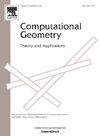Computing Euclidean distance and maximum likelihood retraction maps for constrained optimization
IF 0.4
4区 计算机科学
Q4 MATHEMATICS
Computational Geometry-Theory and Applications
Pub Date : 2024-10-03
DOI:10.1016/j.comgeo.2024.102147
引用次数: 0
Abstract
Riemannian optimization uses local methods to solve optimization problems whose constraint set is a smooth manifold. A linear step along some descent direction usually leaves the constraints, and hence retraction maps are used to approximate the exponential map and return to the manifold. For many common matrix manifolds, retraction maps are available, with more or less explicit formulas. For implicitly-defined manifolds, suitable retraction maps are difficult to compute. We therefore develop an algorithm which uses homotopy continuation to compute the Euclidean distance retraction for any implicitly-defined submanifold of , and prove convergence results.
We also consider statistical models as Riemannian submanifolds of the probability simplex with the Fisher metric. Replacing Euclidean distance with maximum likelihood results in a map which we prove is a retraction. In fact, we prove the retraction is second-order; with the Levi-Civita connection associated to the Fisher metric, it approximates geodesics to second-order accuracy.
计算约束优化的欧氏距离和最大似然回缩图
黎曼优化使用局部方法来解决约束集为光滑流形的优化问题。沿着某个下降方向的线性步骤通常会离开约束条件,因此回缩图被用来近似指数图并返回流形。对于许多常见的矩阵流形,回缩映射或多或少都有明确的公式。对于隐式定义的流形,合适的缩回图很难计算。因此,我们开发了一种算法,利用同调延续来计算 Rn 的任何隐含定义子流形的欧氏距离回缩,并证明了收敛结果。我们还将统计模型视为具有费雪度量的概率单纯形的黎曼子流形。用最大似然法代替欧几里得距离会产生一个映射,我们证明了这个映射是回缩的。事实上,我们证明了回缩是二阶的;利用与费雪公设相关的列维-奇维塔连接,它可以以二阶精度逼近大地线。
本文章由计算机程序翻译,如有差异,请以英文原文为准。
求助全文
约1分钟内获得全文
求助全文
来源期刊
CiteScore
1.60
自引率
16.70%
发文量
43
审稿时长
>12 weeks
期刊介绍:
Computational Geometry is a forum for research in theoretical and applied aspects of computational geometry. The journal publishes fundamental research in all areas of the subject, as well as disseminating information on the applications, techniques, and use of computational geometry. Computational Geometry publishes articles on the design and analysis of geometric algorithms. All aspects of computational geometry are covered, including the numerical, graph theoretical and combinatorial aspects. Also welcomed are computational geometry solutions to fundamental problems arising in computer graphics, pattern recognition, robotics, image processing, CAD-CAM, VLSI design and geographical information systems.
Computational Geometry features a special section containing open problems and concise reports on implementations of computational geometry tools.

 求助内容:
求助内容: 应助结果提醒方式:
应助结果提醒方式:


